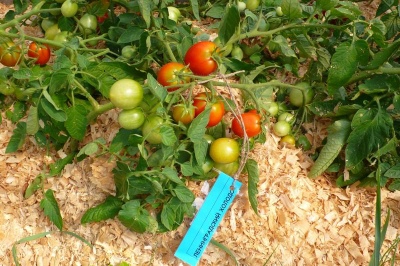
- Authors: Zhidkova V.A., Mikhed V.S., Kononov A.N. (Vavilov Institute of General Genetics)
- Year of approval: 2007
- Category: grade
- Growth type: determinant
- Appointment: fresh consumption, for whole fruit preservation
- Ripening period: ultra early
- Ripening time, days: 65-70
- Growing conditions: for open ground
- Bush size: undersized
- Bush height, cm: 30-35
It is always very difficult to find a good variety of tomatoes for those regions where the summers are short and cool. Nevertheless, there are such varieties. Especially for the described conditions, domestic breeders created a cold-resistant tomato with the telling name Leningrad Chill.
Breeding history
Despite the name, this variety was bred in Moscow, at the Institute of General Genetics. Vavilov. Experienced specialists such as Zhidkova, Mikhed and Kononov took an active part in the breeding work. In 2007, the variety was included in the Rosreestr for cultivation in the open field, while the tolerance contains a rather large list of zoning regions.
Description of the variety
The determinant tomato Leningradskiy Chill is a low-growing non-standard compact bush only 30-35 cm tall. The medium leaves are plain green. It is grown mainly in the open field. On one such bush there are from 3 to 4 brushes, and in each brush 7-8 tomatoes are tied. It is distinguished by an intermediate inflorescence and a peduncle with an articulation. It is characterized by exceptional frost resistance, does not require pinching, and in general, maintenance is minimal. In addition, due to the fact that it ripens early, it simply does not have time to be amazed by late blight.
The main qualities of the fruit
In an unripe state, the fruits are green, but the color of a tomato at the stage of full maturity is red. The Leningrad Chill tomato does not differ in its large size, it weighs only 60-90 grams. Inversely ovate (according to other sources - round), with dense pulp and smooth skin.
Taste characteristics
Tomatoes Leningradsky Chill belong to salad, but are more often used in whole-fruit canning. The berry has a sweet taste with a slight pleasant sourness.
Ripening and fruiting
Leningrad Chill is an ultra-early ripening tomato, a plant needs only 65-70 days to have time to bring a harvest in a short cold summer. So, in early August, you can already start collecting the first red neat fruits.
Yield
As for the yield of the Leningrad chill, these indicators are as follows - on average, 3.1 kilograms are harvested per square meter. And in terms of the number of fruits, each bush gives 18-20 berries per season.
The timing of planting seedlings and planting in the ground
Sowing seeds of ultra-early tomato seedlings does not occur until April 15th. Planting in the ground, taking into account the cold indicators of the northern regions, for which the variety was developed, - only after June 10.

Growing tomato seedlings is an extremely important process, because it largely depends on whether the gardener will be able to harvest at all. All aspects must be taken into account, from seedbed preparation to planting in the ground.
Landing scheme
The bush, although small, is lush, so the scheme according to which it is necessary to plant the Leningrad chill in open ground is 50 by 50 cm.

Growing and care
In the middle lane and other regions with similar climatic conditions, the seeds of this variety can be sown directly into the ground, bypassing all this seedling history.
To get the maximum possible yield of tomato Leningrad Chill, you need:
- sowing seedlings on schedule, as well as transplanting them into the ground;
- stepchildren, which are few, remove with the first 5-6 leaves;
- to carry out top dressing during the periods of flowering and filling of fruits, for this use potassium sulfate, magnesium sulfate, superphosphate.




A plant needs different micronutrients at each stage of growth. All fertilizers can be divided into two groups: mineral and organic. Folk remedies are often used: iodine, yeast, bird droppings, eggshells.
It is important to observe the rate and period of feeding. This also applies to folk remedies and organic fertilizers.


Growing regions
As already mentioned, the completely non-capricious variety Leningradskiy Kholodok was originally created for growing in open beds in a short summer in the north-west, in Karelia and other similar regions. Where he bears fruit perfectly all this time, demonstrating excellent endurance to temperature extremes. But it will grow well and grows not only in the northern, but also in the Central Black Earth Region, in the Central, Volgo-Vyatka, North Caucasian regions. And also in the Volga basin, in the Urals, in Siberia, in the Far East.

























































































